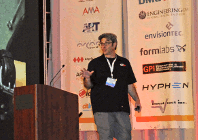
Expert opinions of users from all industries were key to the networking experience of AMUG 2015
Almost half of the 880 registrants at this year’s Additive Manufacturing User Group (AMUG) event in Jacksonville, Florida were first-time attendees, but the relaxed atmosphere and the expertise on show made for a positive networking event.
Speakers usually muzzled by corporate policy opened up and were ready and willing to share their thoughts and opinions on 3D printing, drawing attendees into what must be the world’s fastest growing ‘family’ of 3D printing users.
The general sessions provided an intriguing glimpse into some of today’s most cutting-edge applications of 3D printing. Jason Lopes (pictured above), of special effects studio Legacy Effects, showcased his team’s ability to pull in various technologies, including 3D printing and more traditional fabrication techniques, in order to beat deadlines with super-speed workflows and up-to-the-minute tools.
He gave the crowd a first glimpse at the Carbon3D beta printer they’ve been trialling and some of the parts they’ve been able to produce as a result.

Jason Lopes, Legacy Effects
On a much larger scale, a team from the Oak Ridge National Laboratory (ORNL), an arm of the US Department of Energy, were there to discuss existing FDM [fused deposition modelling] technologies.
Led by Dr Lonnie Love, this group initially assisted in building the Local Motors Strati (the world’s first 3D-printed electric car), before taking the concept forward by printing an entire AC Cobra in just six weeks.
Here, they used the same giant FDM 3D printing technology as they did with the Strati, including ORNL’s own Big Area Additive Manufacturing machine, but what they created, putting down nearly 100 pounds of reinforced plastic per hour for the chassis and bodywork, was something that looked and felt much more like a typical automobile. And once sprayed and assembled, the result was the same sleek bodywork that you might expect to see on a metal or fibreglass shell. The team’s next challenge: to print an entire house in six weeks.
Alongside the general keynote sessions, there were nearly a dozen ‘talk tracks’ and a huge range of hands-on learning sessions going on. The themes of these reveal much about the issues occupying the industry right now.
The industrialisation of 3D printing, for example, was a key topic, from fixing STL files faster to employing the right type of postprocessing equipment.
So were ways to get more (and better) use from the equipment that many attendees already own, typically through additional finishing machines, for vibrating various adhesives through to polishing materials around a submerged 3D printing part, for example.
Claims were made that these types of finishing machines can cut post-processing timescales by as much as 75 percent, but many conference-goers seemed more impressed by the consistency with which hundreds of parts could be finished.
Printing with metals was another area of interest to attendees, from the heavy industrial use cases presented by companies such as DMG Mori and Sciaky, to the infinitely more delicate wax cast parts showcased by SolidScape.

Friendly, open networking was what made the event extra worthwhile
Elsewhere, suppliers were promoting alternatives to metal, with Stratasys in particular talking up its Ultem FDM material as a possible option.
Customers were keen to have their say, too: Andrew Martin, manager of additive manufacturing at industrial giant General Electric (GE) explained how the company’s jet engines are already benefiting from the use of direct-metal printing.
Even with the ultra-conservative designs needed to handle flying many thousands of miles each week, he said, GE has turned to 3D printing since it discovered this would enable it to unify 20 complex parts in a single build – in this case, the fuel injector nozzles for its GEnx engines.
And Jim Lahood, a 3D printing specialist at industrial equipment company Caterpillar, explained to the audience how the company has established a 3D printer knowledge-transfer system between its various manufacturing plants, allowing them to share their expertise and tips on where the technology might best be applied.
By putting FDM 3D printers on Caterpillar shop floors, he said, custom gauges, jigs and fixtures can now be built faster than they previously could in metal. The low costs involved also mean that employees can experiment with ergonomic, time-saving or safety enhancing tool grips. The end result has been savings amounting tomillions of dollars, he told attendees.
Given the hype that 3D printing continues to generate, it was refreshing to attend an event so firmly grounded in the present, with a keen eye on what the technology can achieve today and where it may take us tomorrow, not in 50 years’ time. 
The latest in 3D printing from the US Additive Manufacturing Users Group
Default






